Submissions for the Critical Analysis category should critically evaluate or analyze a piece of literature, a theatrical performance, a work of visual art, a historical moment, a philosophical argument, a social movement, etc. Submissions should not exceed 20 pages. Skylar Downs wrote the 2nd place submission in the Critical Analysis Category for the 2024 President’s Writing Awards.
About Skylar

Skylar Downs is a senior Psychology student with minors in Gender Studies and Family Studies. He has a passion for promoting mental health and social change. After graduating with his Bachelor’s in Psychology, he would like to continue his education and pursue a Master’s in Counseling, with the goal of becoming a mental health counselor. He would like to focus his career on helping LGBTQ+ youth and young adults with their mental health. In his free time, Skylar likes to spend time with friends, read, and play games.
Winning Manuscript – The Prevalence of Anti-Black Racism in Psychology
Abstract
American psychology is deeply rooted in anti-Black racism. Early American psychologists defined several mental disorders that allegedly only affected Black and African American people, especially slaves. These disorders included drapetomania and dysaesthesia aethiopica. Scientifically racist beliefs such as these lasted through the 20th century and shaped how Black and African American people have been treated on a systemic level. Until the mid-1950s, schizophrenia was widely regarded as a docile disorder that most commonly affected middle-class white housewives. After the start of the civil rights movement, there was a shift in the way that schizophrenia was perceived. The condition was referred to as ‘protest psychosis’ that resulted from civil rights activism, and it was characterized by aggressive Black men. In the years following this shift, many advertisements for antipsychotic drugs were published and ran alongside the Archives of General Psychiatry with overt themes tying the condition to aggressive Black men and ‘primitive’ African practices. Modern statistics show that African Americans are more frequently diagnosed with schizophrenia, even when experiencing identical symptoms to those of white people with mood disorders. Additionally, Black men make up a disproportionate amount of the United States prison system and are more likely to be incarcerated if they have schizophrenia or a similar disorder. Despite the long history of racism, the American Psychiatry Association and the American Psychological Association did not issue apologies for their involvement in racism until 2021.
Keywords
Racism, psychology, scientific racism, American history, African Americans, civil rights, schizophrenia
The Prevalence of Anti-Black Racism in Psychology
The prevalence of racism in psychology is a topic that has gained increased attention in recent years. American psychology has a history rooted in scientific racism, which has had a significant impact on how Black and African American people have been treated on a systemic level. This paper will explore the history of anti-Black racism in mental health care, from early American psychologists defining mental disorders that allegedly only affected Black and African American people to the present day, where statistics show that African Americans are more frequently diagnosed with certain mental disorders and are disproportionately represented in the United States prison system. The paper will also discuss the apologies issued by the American Psychiatric Association and the American Psychological Association for their involvement in perpetuating racism in America.
The History of Anti-Black Racism in Mental Health Care
The field of psychology in America has deep connections to scientific racism that helped shape the systemic treatment of Black and African American people. Starting with the year 1792, timelines have been provided in Figures 1 and 2 to aid in the visualization of significant events that contributed to the formation of racial hierarchy in the United States.

Figure 1 Timeline of Racism in Psychology (1)
1792: Benjamin Rush describes dark skin as a form of leprosy. 1840: U.S. Census findings show a higher reporting rate for insanity among Black people in free states. 1851: Samuel Cartwright describes two conditions exclusive to Black slaves. 1861: The Alabama Insane Asylum opens with the first segregated facilities available.
1904: Robert Bennett Bean publishes research to show differences between Black and white brains.
1913: An article is published in Psycoanalytic Review asserts that Negroes are mentally unfit for freedom.
1920s-1940s: The public image of schizophrenia was a middle-class white woman with mood swings.
1933: The last segregated mental hospital in the United States opens in Oklahoma.
1954: The Civil Rights Movement begins.
1955: Deinstitutionalization begins in the United States.
Note. The information ranging from 1792-1904 is sourced from Structural Racism in American Psychiatry and APA: Part 1, Part 2, & Part 3, by Jeffery Geller, 2020. The information for the 1920s-1940s, as well as 1955, is sourced from The historical roots of racial disparities in the mental health system by Tahimi Perzichilli, 2020. The information for 1954 is from The Protest Psychosis: how schizophrenia became a black disease, by Jonathan Metzl, 2011.

Figure 2 Timeline of Racism in Psychology (2)
1956: An influx of articles are published associating schizophrenia with violent Black men.
1957: EEG technology shows no differences between Black and white brains.
1963: The movie “The Corridor” portrays a young Black man who is institutionalized with schizophrenic delusions.
1966: The Chicago Tribune publishes an article titled “FBI Adds Negro Mental Patient to 10 Most Wanted List.”
1968: An article published in the Archives of General Psychiatry attributes Black psychotic hostility to activism involvement.
1974: An advertisement fot the antipsychotic drug Haldol depicts an aggressive Black man.
Mid to Late 1970s: Advertisements for the antipsychotic drug Thorazine depict traditional African tools as primitive.
1974: An advertisement for the antipsychotic drug Haldol depicts an aggressive Black man.
2017: Black people with schizophrenia are more likely to be incarcerated than other races.
2021: The American Psychiatric Association publishes official apologies for their involvement in structural racism in America.
Note. The information for 1956, 1963, 1966, 1968, 1974, and the Mid to Late 1970s is sourced from The Protest Psychosis: how schizophrenia became a black disease, by Jonathan Metzl, 2011. The information for 1957 is sourced from Structural Racism in American Psychiatry and
APA: Part 3, by Jeffery Geller, 2020. The information for 2017 is sourced from Mental Health Disparities: African Americans, by the American Psychological Association, 2017. The information for 2021 is sourced from APA’s Apology to Black, Indigenous and People of Color for Its Support of Structural Racism in Psychiatry by the American Psychiatric Association, 2021, as well as from Apology to People of Color for APA’s Role in Promoting, Perpetuating, and Failing to Challenge Racism, Racial Discrimination, and Human Hierarchy in U.S. by the American Psychological Association, 2021.
Early Psychology
Early American psychologists defined disorders that they believed to only affect Black and African American people, especially slaves. One of the first American psychologists, Dr. Benjamin Rush, has been considered as the “father of American psychiatry”, and is credited as one of the signers of the Declaration of Independence (Geller, 2020a; Perzichilli, 2020). In 1792, Rush described dark skin as a symptom of a disease similar to a mild form of leprosy, and he claimed that the only cure was to become white (Perzichilli, 2020). To support his claim, he “produced a Black man who was turning white” and suggested scrubbing the skin hard to alleviate the condition (Geller, 2020a). From a modern perspective, the man likely had vitiligo (Geller, 2020a). The condition that Rush described was previously described as ‘Negritude’, but no evidence has been found to support the claim that Rush used the term (Warner, 2021). Instead, the first use of the term is credited to French poet Aimé Césaire, first appearing in his 1935 “Conscience raciale et revolution sociale” (Reilly, 2020). Négritude was created by French-speaking African and Caribbean writers in protest of French colonialism and the policy of assimilation, and the movement was inspired by the Harlem Renaissance (Britannica, 2023).
In 1840, the United States census created a category of “insane and idiotic” (Geller, 2020a). Analysis of the census results revealed significant differences between the rate at which Black people were categorized as insane depending on whether they lived in a free or slave state. According to Geller (2020a), there was an average of 1 to 144.5 Black insane or idiotic people in free states, but only an average of 1 to 1,558 in slave states. The lower ratio indicated higher reported rates of insanity or idiocy in free states when compared to slave states, correlating with the claims that free slaves were suffering from mental disorders.
A few years later in 1851, Samuel Cartwright identified two new ‘diseases’ that affected Black people. He described a disease that he labeled as drapetomania, which attempted to explain why slaves would flee captivity (Geller, 2020a; Perzichilli, 2020). He claimed that the condition was caused by treating slaves as equals with an “unnatural kindness”, and Cartwright believed that it was a treatable condition that could be fixed by treating slaves as submissive (Metzl, 2011, p. 30; Perzichilli, 2020). The second disease described by Cartwright – dysaesthesia aethiopica – was described as the cause of laziness and “disrespect for master’s property” among slaves (Geller, 2020a; Metzl, 2011, p. 30; Perzichilli, 2020). The treatment advised for this disease, recommended by Cartwright, was “whipping, hard labor, and in extreme conditions, amputation of the toes” (Metzl, 2011, p. 30). These diagnoses continued to be used after the abolishment of slavery in 1865 – drapetomania remained in the Practical Medical Dictionary until 1914 (Perzichilli, 2020).
A founder of the American Psychiatric Association had a role in the segregation of asylums. Thomas Kirkbride asserted that “The idea of mixing up all colors and classes, as seen in one or two institutions in the United States, is not what is wanted in our hospitals for the insane” (Geller, 2020b). Kirkbride’s stance on segregation influenced how the United States would structure mental institutions. In 1861, Alabama opened a mental institution that was segregated by race, and by 1889, Virginia opened the first completely separate asylum for Black patients (Geller, 2020b). According to Geller (2020b), new completely segregated institutions would continue to open until the last segregated hospital opened in 1933. As more slaves were freed, more Black individuals were classified as insane, which was attributed to the amount of segregated institutions that opened during that period.
A study was conducted in 1904 by Robert Bennett Bean in an attempt to display differences between white and Black brains. Bean presented his findings to the Association of American Anatomists and concluded that there were structural differences between the two. He asserted that Black brains had a smaller frontal lobe and anterior corpus callosum when compared to white brains, which he attributed to Black people being more objective and having lower mental capacities than white people (Geller, 2020c). There were multiple attempts to disprove Bean’s scientifically racist findings over the next few decades. In 1957, electroencephalogram (EEG) technology allowed researchers to make accurate measurements of brain size, and no significant differences were found between Black and white brains (Geller, 2020c). Despite many sources disproving that there was a difference in brain size between races, Bean’s research was widely accepted by the scientific community and used as the basis for research.
As time progressed, new perspectives were introduced to control Black individuals and separate them from society. In 1913, an article was published in the Psychoanalytic Review that took the stance that Black people were mentally unfit for freedom and should be admitted to mental hospitals (Metzl, 2011, p. 31; Perzichilli, 2020). Arrah Evarts, a psychiatrist from the Government Hospital for the Insane, implied that slavery was beneficial to Black people, “This bondage in reality was a wonderful aid to the colored man. […] It has been said by many observers whose words can scarce be doubted that a crazy Negro was a rare sight before emancipation” (Metzl, 2011, p. 31). It was believed that Black individuals were mentally unable to cope with freedom and that they were benefiting from slavery because they did not have to think freely while enslaved.
In the period between the 1920s and the early 1950s, schizophrenia was a mental disorder that was most commonly associated with middle-class white housewives. Schizophrenia was often referred to as a “docile, harmless disorder” (Perzichilli, 2020) that was associated with the stress of modern civilization (Metzl, 2011, p. 39). The Snake Pit, a semi-autobiographical novel by Mary Jane Ward, was published in 1946 and became a representation of the way that schizophrenia affected housewives. Metzl (2011) provides that the novel was partially responsible for the American perspective of schizophrenia at the time because it reaffirmed “comfortable stereotypes” about the disorder being an illness of whiteness. Until the mid-1950s, the association of schizophrenia with white women stayed mainstream. This generated advertisements for antipsychotic drugs like Thorazine and Serpasil that depicted white women, shown in Figures 3 and 4.
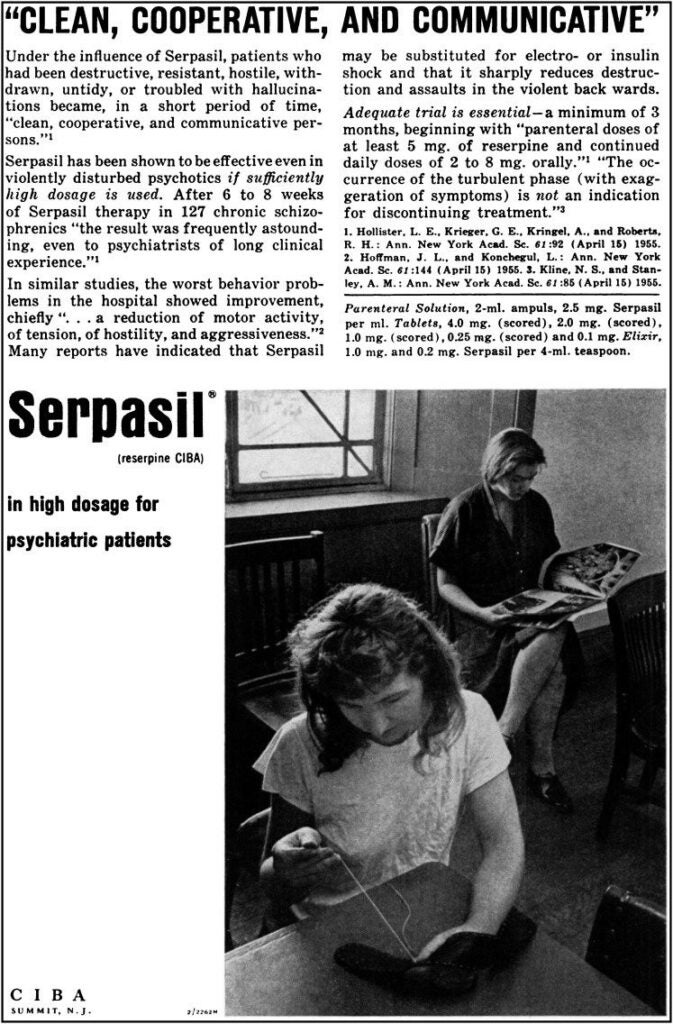
“Clean, Cooperative, and Communicative”
Serpasil, in high dosage for psychiatric patients.
Note. This advertisement appeared in the American Journal of Psychiatry, Issue 112, p. xxxiii.
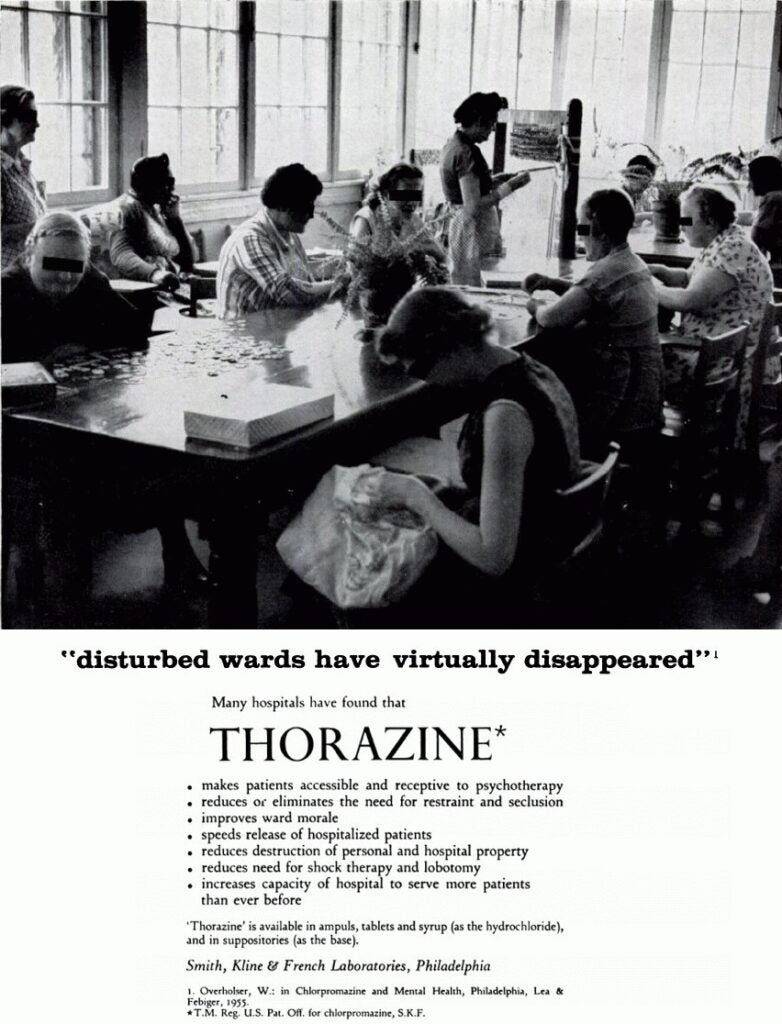
“disturbed wards have virtually disappeared”
Note. This advertisement appeared in Mental Hospitals, Issue 7, Volume 8, p. 2.
Mid-Century Perspectives
After the civil rights movement started in 1954, there was a shift in the American perception of schizophrenia due to multiple contributing factors. In 1955, the process of deinstitutionalization began as the United States government dissolved support for asylums, mental hospitals, and other long-term inpatient care facilities in favor of mental health centers (Perzichilli, 2020). During the same year, the antipsychotic drug chlorpromazine was approved for use across the United States. Metzl (2011) describes the drug as a tranquilizer that caused a change in the way that patients were given treatment based on hospital reports, with a shift from “restoration – our goal is to return this patient to normal functioning – to containment – we used chemical therapies to control this patient’s violent tendencies”. It became clear that the goal of these institutions was not to rehabilitate their patients but to control and restrain them. Starting in the late 1950s, the words schizophrenic and Negro began appearing more frequently in academic articles (Metzl, 2011, p. 110). It was noted by Metzl (2011) that none of the articles used the terms Black or African American. By the year 1956, there was a distinct increase in the number of articles referring to violent, schizophrenic Black men (Metzl, 2011, p. 111). Schizophrenia was no longer a harmless disorder that affected white housewives – instead, it represented aggressive Black men, especially those who were involved with the civil rights movement.
In the years following the upsurge in articles that associated Black men with schizophrenia, mainstream media began to represent this change. Samuel Fuller’s 1963 film, Shock Corridor, perpetuated the stereotype by portraying a young Black man who had been committed to a mental institution for schizophrenic delusions that began after his involvement in desegregation efforts associated with the civil rights movement (Metzl, 2011, p. 116; 2012). During this time, many news stories generated panic as they warned the public of Black schizophrenic criminals who were dangerous to society. One notorious piece of news referenced by Metzl (2011) was published by the Chicago Tribune with the headline, “FBI Adds Negro Mental Patient To ‘10 Most Wanted’ List”, with the article describing Leroy Ambrosia Frazier as “an extremely dangerous and mentally unbalanced schizophrenic escapee from a mental institution”.
One of the most infamous pieces of literature that designated schizophrenia as a disorder affecting Black males was the 1968 article by Walter Bromberg and Franck Simon, published in the Archives of General Psychiatry. The article asserted that participation in civil rights movements, such as Black Power, drove Black men to insanity, and described Black liberation movements as causing delusions, hallucinations, and violence in Black men (Metzl, 2011, p. 100). They believed this ‘protest psychosis’ was being influenced by social pressures, religious doctrine, African ideology, and the denial of white values, and partially attributed the ideologies of Black activists to causing the disorder (Metzl, 2011, p. 101). The research that Bromberg and Simon presented was used as the basis for research articles that came out in the years following its publication, which caused further perpetuation of ‘protest psychosis’ in scientific research.
As articles were published throughout the 1960s and 1970s, advertisements for various antipsychotic drugs were included in the prints. There was a notable difference between these advertisements and the mid-1950s advertisements depicting mild-mannered white women in mental wards – the new advertisements depicted aggressive-looking Black men and described traditional African tools as ‘primitive’. In the 1974 Haldol advertisement, the text asks, “Assaultive and belligerent? Cooperation often begins with Haldol” above the image of an angry Black man (Metzl, 2012). Examples of these advertisements can be seen in Figures 5-8.
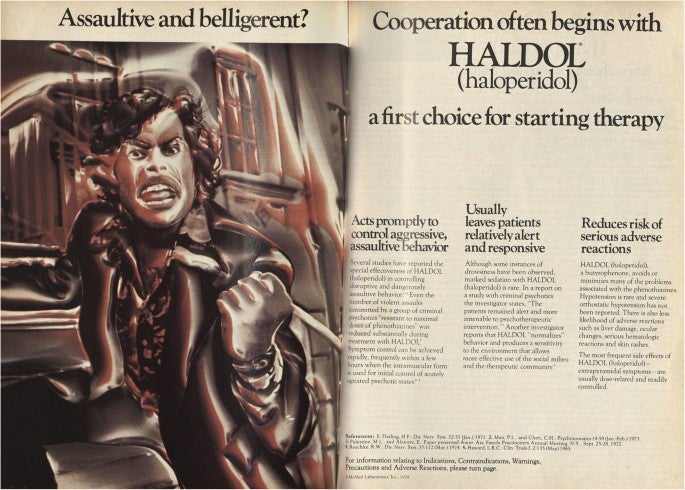
Assaultive and belligerant? Cooperation often begins with Haldol a first choice for starting therapy
Note. Image sourced from the Archives of General Psychiatry, 1974.
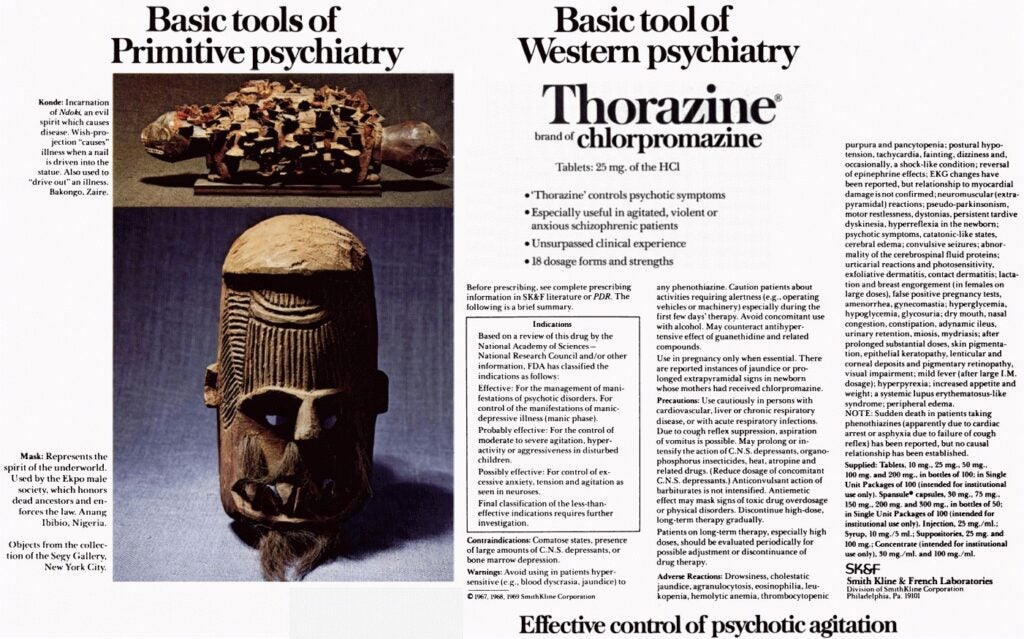
“Basic tools of Primitive psychiatry” includes a Konde and a Mask. Konde: Incarnation of Ndoki, an evil spirit which causes disease. Wish-projection “causes” illness when a nail is driven into the statue. Also used to “drive out” an illness. Bakango Zaire. Mask: Represents the spirit of the underworld. Used by the Ekpo male society, which honors dead ancestors and enforces the law. Anang Ibibio, Nigeria. Compared to “Basic tool of Western psychiatry” Thorazine: Effective control of psychotic agitation.
Note. Image sourced from Hospital & Community Psychiatry, 1975.
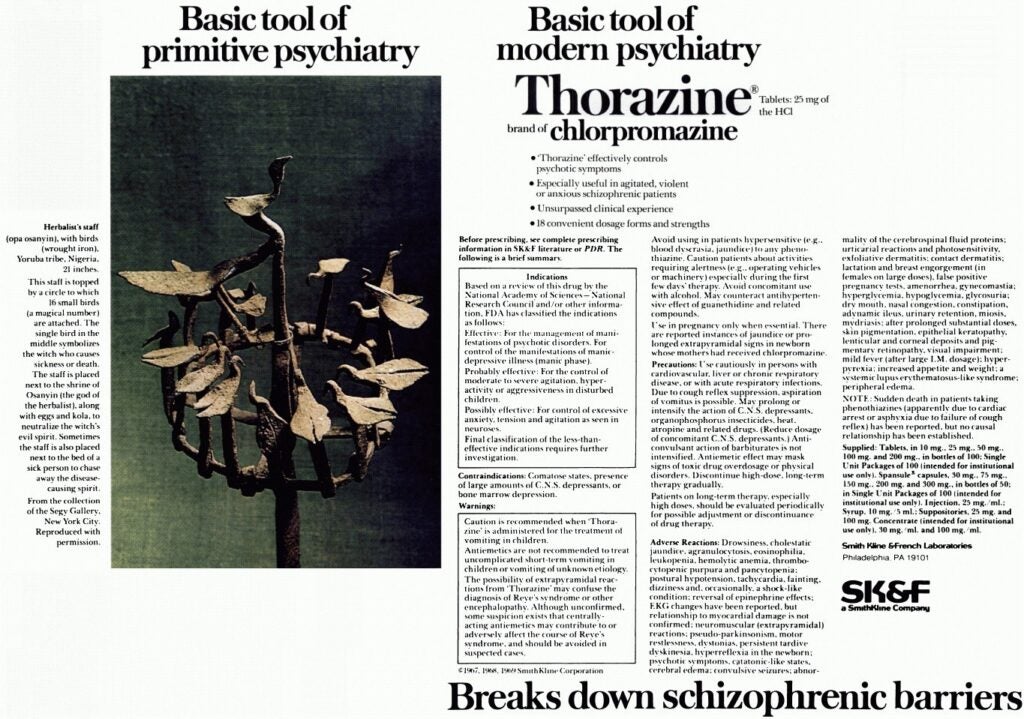
Basic tool of primitive psychiatry with an Herbalist’s staff (opa osanyin,) with birds (wroght iron), Yoruba tribe, Nigeria. 21 inches. This staff is topped by a circle to which 16 small birds (a magical number) are attached. The single bird in the middle symbolizes the witch who causes sickness or death. The staff is placed next to the shrine of Osanyin (ths god of the herbalist), along with eggs and kola, to neutralize the witch’s evil spirit. Sometimes the staff is also placed next to the bed of a sick person to chase away the disease causing spirit. Compared to “Basic tool of Western psychiatry” Thorazine: Breaks down schizophrenic barriers.
Note. Image sourced from Hospital & Community Psychiatry, 1977.
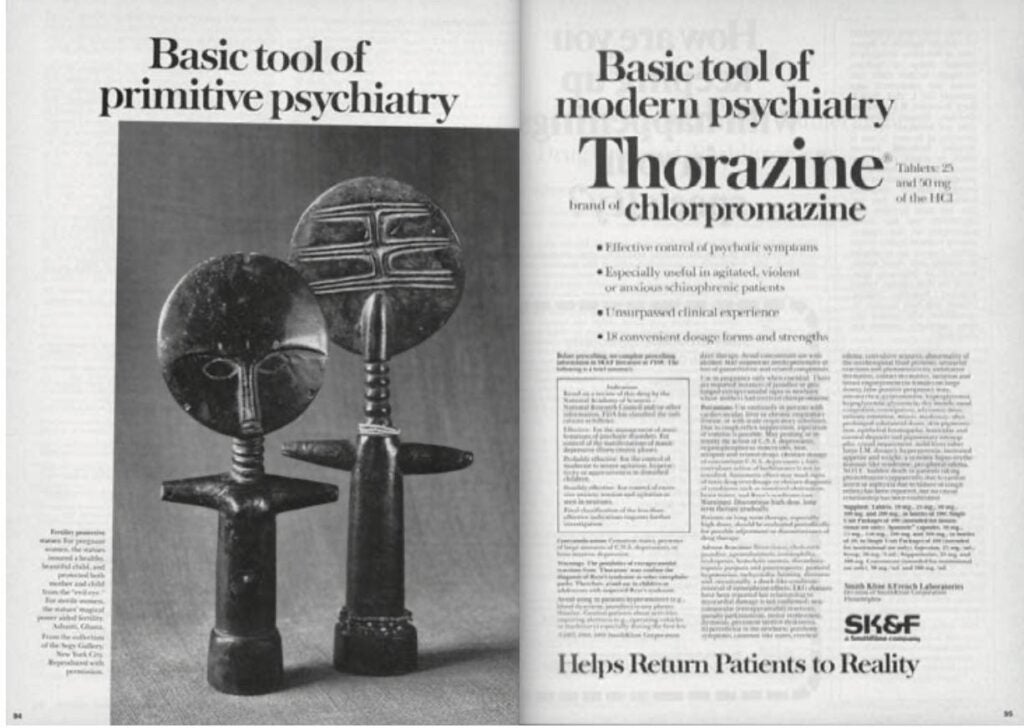
Note. Image sourced from Archives of General Psychiatry, 1978.
Modern Perspectives: How Have Things Changed?
As time has passed, the fields of psychiatry and psychology have largely attempted to move forward from their racist past. Contemporary psychologists acknowledge the harm that has been caused by slavery. Dr. Kenneth V. Hardy describes how the residuals of slavery affect rage in African Americans, in a video presentation from 1995. Dr. Hardy explains,
As silence and the loss of one’s voice that is, the inability to speak and act on one’s own behalf, have characterized the African American experience historically, so has rage. Because of our shared legacy of slavery, oppression, and racism, many of us struggle with the management and expression of rage. What many white people often see as the excessive and inexplicable anger of Black people is a residual of generations of humiliation and degradation (Hardy, 1995, 11:55).
Rage is not the only lingering factor related to scientific racism and oppression. According to statistics provided by the American Psychiatric Association (2017), African Americans are still more frequently diagnosed with schizophrenia than mood disorders when compared with white people with the same symptoms. Additionally, Black individuals with mental health conditions, especially schizophrenia and other psychoses, are more likely to be incarcerated than people of other races (American Psychiatric Association, 2017). African Americans in modern America are still more likely to be diagnosed with schizophrenia and are more susceptible to being incarcerated if diagnosed with schizophrenia. Mental Health America (2023) reports that Black and African American people make up 13% of the U.S. general population, but are severely overrepresented in the prison system, making up nearly 40% of the U.S. prison population. Stigma still deters African Americans from seeking mental health services, with Black and African American men holding the most stigma around seeking mental help (Mental Health America, 2023). When considering the treatment that Black and African American men have endured over two centuries, it is understandable that they feel apprehensive about seeking mental health care from the same institutions that fostered their mistreatment and inequity.
The American Psychiatric Association (APA) and the American Psychological Association (APA) issued formal apologies for their involvement in perpetuating racism in America in 2021. While efforts had been made to improve the fields before these statements were made, there had been no public statements from the two associations until January 18, 2021, when the American Psychiatric Association published its formal apology. In the text, the association wrote, “Since the APA’s inception, practitioners have at times subjected persons of African descent and Indigenous people who suffered from mental illness to abusive treatment, experimentation, victimization in the name of ‘scientific evidence,’ along with racialized theories that attempted to confirm their deficit status” (American Psychiatric Association, 2021). They emphasize that, moving forward, their association will strive for social equality, health equity, and fairness in their work (American Psychiatric Association, 2021). In the same year, the American Psychological Association adopted a resolution that would address disparities and inequities in the field of psychology. They begin the statement by stating, “The American Psychological Association failed in its role leading the discipline of psychology, was complicit in contributing to systemic inequities, and hurt many through racism, racial discrimination, and denigration of people of color, thereby falling short on its mission to benefit society and improve lives” (American Psychological Association, 2021). The American Psychological Association’s resolution is a comprehensive list of the steps that they are taking to ensure that they do not continue perpetuating racism and racial hierarchy in America, and will attempt to mitigate the harm that has already been done.
Conclusion
The involvement of race in mental health care is a complex, historical issue that requires careful consideration when entering the field of psychology. As historical evidence suggests, psychology was previously used as a means of controlling Black and African American people, especially men. Control manifested through the diagnoses described by early American psychologists, as well as the shift in how schizophrenia was characterized after the civil rights movement began. As we move towards the betterment of the field of psychology, it is important to remember that progress can only be made through action and that condemning the racist past of the field is only the first step in creating a better environment and reducing stigma around mental health care for those affected.
References
American Psychiatric Association. (2017). Mental health disparities: African Americans. Psychiatry.org. https://www.psychiatry.org/File%20Library/Psychiatrists/Cultural-Competency/Mental-H ealth-Disparities/Mental-Health-Facts-for-African Americans.pdf
American Psychiatric Association. (2021, January 18). APA’s apology to black, indigenous and people of color for its support of structural racism in Psychiatry. Psychiatry.org – APA’s Apology to Black, Indigenous and People of Color for Its Support of Structural Racism in Psych. https://www.psychiatry.org/newsroom/apa-apology-for-its-support-of-structural-racism-in-psychiatry
American Psychological Association. (2021, October 29). Apology to people of color for APA’s role in promoting, perpetuating, and failing to challenge racism, racial discrimination, and human hierarchy in U.S. American Psychological Association. https://www.apa.org/about/policy/racism-apology
Britannica, T. Editors of Encyclopaedia (2023, May 9). Negritude. Encyclopedia Britannica. https://www.britannica.com/art/Negritude
Geller, J. (2020a). Structural racism in American Psychiatry and APA: Part 1. Psychiatric News, https://doi.org/10.1176/appi.pn.2020.7a18
Geller, J. (2020b). Structural racism in American Psychiatry and APA: Part 2. Psychiatric News, https://doi.org/10.1176/appi.pn.2020.7b27
Geller, J. (2020c). Structural racism in American Psychiatry and APA: Part 3. Psychiatric News, https://doi.org/10.1176/appi.pn.2020.8a16
Hardy, K. V. (Director). (1995). Psychological Residuals of Slavery. [Video/DVD] Mill Valley, CA: Psychotherapy.net. https://search.alexanderstreet.com/view/work/bibliographic_entity%7Cvideo_work%7C1 778701
[Haldol advertisement]. (1974). Archives of General Psychiatry, 31(5), 732-733.
Mental Health America. (2023). Black and African American communities and Mental Health.
Mental Health America. https://www.mhanational.org/issues/black-and-African American-communities-and-mental-health
Metzl, J. M. (2011). The protest psychosis: how schizophrenia became a black disease. Beacon. Metzl, J. M. (2012). Mainstream anxieties about race in antipsychotic drug ads. AMA Journal of Ethics, 14(6), 494-502. https://doi.org/10.1001/virtualmentor.2012.14.6.imhl1-1206
Reilly, B. J. (2020). Négritude’s Contretemps: The Coining and Reception of Aimé Césaire’s Neologism. Philological Quarterly, 99(4), 377–398. www.proquest.com/scholarly-journals/négritudes-contretemps-coining-reception-aimé/do cview/2509036438/se-2
[Serpasil advertisement]. (1955). American Journal of Psychiatry, 112, xxxiii.
[Thorazine advertisement]. (1956). Mental Hospitals, 7(8), 2.
[Thorazine advertisement]. (1975). Hospital & Community Psychiatry, 26(7).
[Thorazine advertisement]. (1977). Hospital & Community Psychiatry, 28(1).
[Thorazine advertisement]. (1978). Archives of General Psychiatry, 35(1), 94-95.
Warner, J. (2021, April 30). Psychiatry confronts its racist past, and tries to make amends. The New York Times. https://www.nytimes.com/2021/04/30/health/psychiatry-racism-black-americans.html